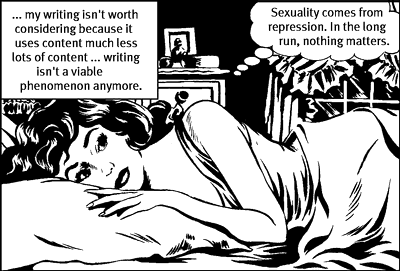
| From New Motor Queen City: Requiem for Pussy by Patricia Seaman. Published by Coach House Books. Reproduced by permission. |
 |
Like Christy Sheffield Sanford's Red Mona, Patricia Seaman's New Motor Queen City seems to owe more to popular culture discourses and intertextual references than to literature. Under the guise of traditional comic book look and style, Seaman toys with the gender stereotyping for which the comic book genre is infamous. She is a respected Toronto fiction writer of evocative and beautiful prose, and a member of the editorial collective of the Canadian feminist literary magazine Tessera. New Motor Queen City is a departure for her, being considerably leaner on text than her other writings, as well as her first graphic novel.
This novel is being published online in an eight-part serial form by Coach House Books in Toronto and, once completed, will be available as a book. As a book, however, some of the feminist and specifically hypertextual features will be lost. The reader can approach the text as a random collection of screens or read it in a linear fashion like a comic strip. Comic books with their gaps and their reader-driven links are innately hypertextual, of course, and Seaman makes the most of this, using a disjunctured narrative with character 'types' in conjunction with the existing attributes of the form. Her text is evolving as it is being written and to date three chapters have been uploaded: 'The Adventures of Elvis,' 'Hard On Road Killers' and 'Requiem for Pussy.' Chapter One, parodies an Elvis lookalike (or is it Elvis?) who is a heel and a bully, clearly possessed by his own demons, and showing little understanding for the 'super-octane girls' who think circles around him. 'Hard On Road Killers' critiques capitalism and patriarchal institutions (romance, love, marriage, the American dream) through self-reflexive irony and startling juxtapositions of the philosophical and the mundane. Chapter Three, 'Requiem for Pussy,' is an elegiac tribute to the bad girl novelist Kathy Acker and a self-reflexive (but not repentant!) examination of the sacrifices women make when they live outside of expected morality.
While each chapter is freestanding and not apparently part of the same narrative, they all are concerned with "the ordinary violence of love" ('Hard On Road Killers' 31) and with issues of gender stereotyping. Together they form a montage or collage of the seedier side effects of abstract patriarchal discourse. Seaman juxtaposes the rhetoric of society with its crass, crude underbelly; the text is always surprising not in the least because of the shocking stitching of American cultural icons, crude language (spoken by a bride in full regalia), drug culture and promiscuous sex with hard-core feminist theory and writerly dilemmas. Where else can we meet a battered heroine who can reflect: "Should I act on what I've learned, internalizing the violence that's done to me?" (HOR 16) or a hero who critiques his female lover's writing (and presumably sexual) style while locked in the trademark comic strip embrace?
While New Motor Queen City is reminiscent of David Boswell's 1980's spoof on the superhero, Reid Fleming: The World's Toughest Milkman, Seaman does not lack for feminist foremothers in the history of comic book discourse. Nicole Hollander, Lynda Barry, Debbie Drechsler and particularly Julie Doucet have come before, but none of them try to work so closely within the traditional comic art form as Seaman does, nor have they moved into the honeycomb of electronic spaces.
Patricia Seaman:
New Motor Queen City Toronto: Coach House Books, 1997-1998. Online.
Alternative Comic Links:
The ABCs of Alternative Comics.
URL: http://www.chbooks.com/onlinebooks/seaman/nmqc.html
URL: http://www.tcj.com/abc/abc.html
Comic Journal Website.
URL: http://www.tcj.com/
Comics Scholarship (Annotated Bibliographies).
URL: http://www.sp.uconn.edu/~epk93002/ComicsScholarship/
ism comics: small press comics in a big world
URL: http://ism.opal.de/
Drawn & Quarterly.
URL: http://www.hardboiledegg.com/quarterly/
Fantagraphics Books.
URL: http://www.fantagraphics.com/
JC's Comic Book Collection.
URL: http://www.chivian.com/chivian/
Comics.html#Independents
Kitchen Sink Press.
URL: http://www.kitchensink.com/
Small Press Zone.
URL: http://www.cloudnet.com/~hamlinck/spz.htm

Carolyn Guertin